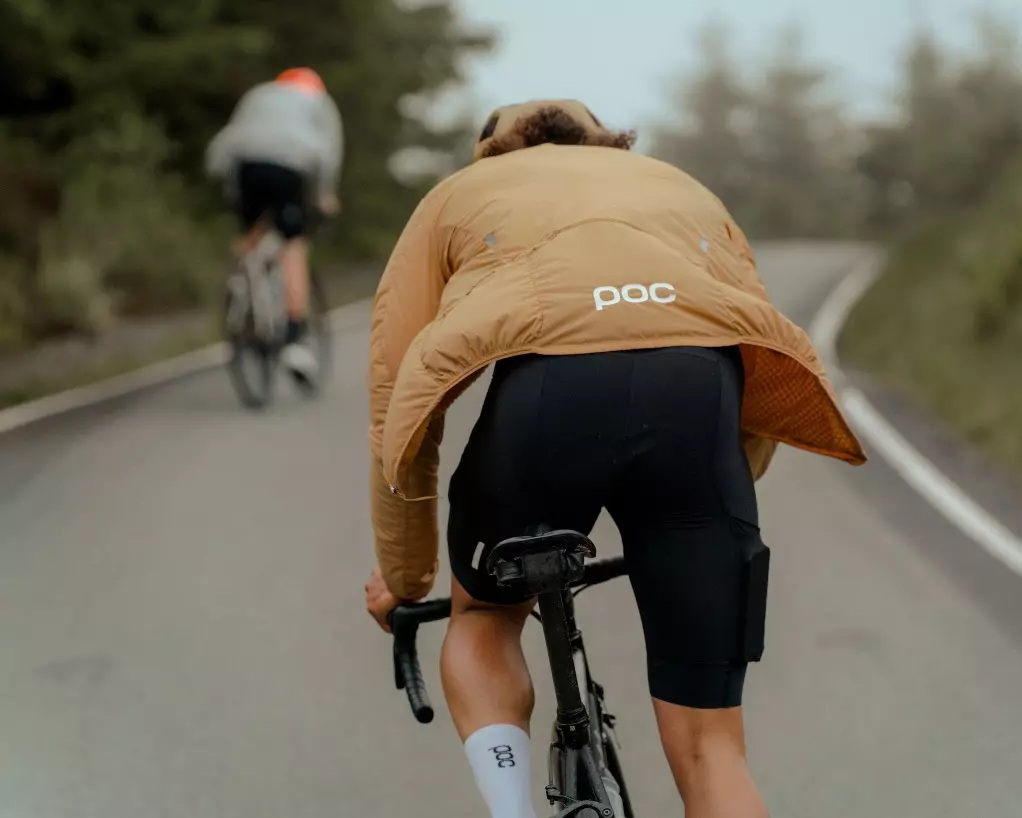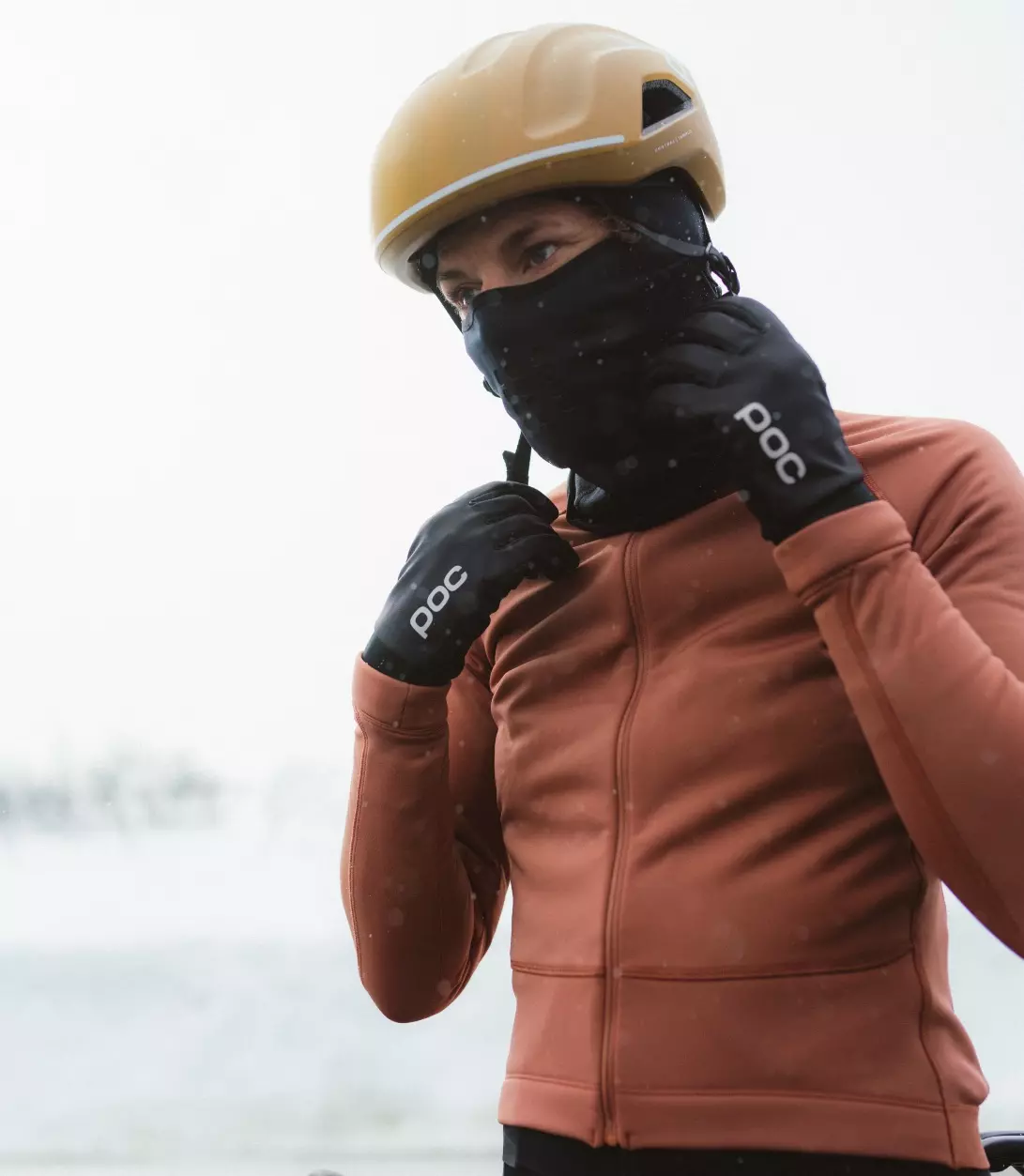What are the main benefits of layering for winter cycling? Does it make you warmer or is there more to it?
If you layer in the right way, it will make you both warmer and more comfortable. If you feel comfortable during your ride, you will also perform better and have a nicer ride! It also helps you adapt if the conditions are changing during your ride. But an important note is that the layers need air in between for the fabrics to function properly. That’s what makes you warm and comfy, and helps transport all the moisture away from your body.
Let’s start with the upper body. What to look for in base layers? Is merino the best material?
Merino wool is a very good material to use as a base layer as it has a lot of good natural properties and is very versatile. It can actually be used all year round! So, if you can only pick one base layer, merino wool should be your first choice. But there are also man-made materials like polyester and polypropylene, which can be a better choice if you are doing a high-intensity ride. They offer excellent wicking and moisture management properties.
What’s the right fit for a base layer?
It should be a tight fit as the base layer should wick away the sweat from your skin and transport it out to the next layer. If it’s not tight, your sweat will stay on your body and you will quickly start feeling cold.

What’s important when buying mid-layers? What are some good materials?
Mid-layers should provide insulation and warmth if needed. In general, it’s good if the mid-layer has some lift in the material. For example, fleece or some type of airy construction is a good choice. If you ride in very cold conditions, a mid-layer can also be a padded insulated construction if you want high insulation. Fibre-wise, wool, polyester or polyamide are good choices.
What are the pros and cons of using thermal sleeves instead of a long-sleeve jersey?
If you use sleeves, you have the versatility of mapping your body with different layers. Sleeves and a vest are a really good combo for winter cycling as they help you to really adapt your layering set-up to suit the needs of different parts of your body. If you use a long-sleeve jersey, you don’t have the same versatility but you also don’t need to think about the gaps that can appear if you use sleeves. It’s worth trying out the two options as, in the end, it’s a personal preference as well.
How to choose a top layer that will keep you dry?
I think the top layer, also called the outer layer, is the layer that you really need to adapt depending on the conditions of the day. An outer layer for winter should protect you from many different elements like wind, water, snow and also splashing from the ground. If there isn’t much of a downpour, the best outer layer is often a wind and water-resistant piece of clothing that does not have a very closed-in construction but still protects you from gentle rain. If there is rain or snow, a jacket with a good membrane that keeps the water out but also lets moisture out is the best option.
What should a reliable outer layer be made from?
Preferably, it should be a woven construction and the preferred fibres to be used would be polyester or polyamide. It’s very important that the fabric is treated with a good, sustainable, water-repellent treatment (DWR), especially if it’s a multi-layer construction with a membrane. This ensures that the outer layer stays dry and forces water and rain to pearl away.

Which other pieces of gear should have water-repellent or waterproof materials?
Shoe covers and gloves are very nice to have with both wind and water-repellent materials. Depending on where you ride, it can also be nice to protect the front and back of your thighs.
What are the advantages of choosing a vest as the top layer? What pieces of apparel go well with a vest?
Depending on how cold it is, a vest could be a nice extra layer to have for the start of your ride. If you want to perform at your best, it’s important that your heart and lungs stay warm, and a vest targets these parts of your body. Many riders in POC follow a similar personal favourite set-up, which is to use a long-sleeve jersey together with a vest!
At what temperature would you recommend cyclists add a 2nd and 3rd layer?
This is a question that really depends on other parametres like intensity level, terrain, and length of your ride. A setup that works for a short, intense and very steep ride will be very different from something you should use on a long, slow and flat ride. It also depends on your personal preferences and your body’s behaviour. In general, we would recommend being a bit overdressed while having the option to remove a layer or ventilate out the heat. These days, it is more likely than not that you will have a small bike bag on a gravel or winter ride. That makes it easier to bring a bit of extra clothing without stretching your jersey pockets. Also, the outside temperature is one thing but wind conditions are also very important when riding in colder conditions. They influence the chill effect a lot. So, you can’t really decide on your layering based on temperature alone, you need to look at all the different elements when dressing.

Now the lower body. Should cyclists layer when it comes to legs too?
Yes, legs should also be layered! They are not as sensitive as the upper body but wind protection is the most important for the legs, especially the thighs, which have to stay warm to perform. As a general rule, you should be able to wear one fewer layer on your legs than on your upper body when dressing for mildly cold conditions. When you’re riding in the depths of winter, your legs will need an extra insulation layer, especially around your thighs.
Are regular BIB shorts and leg warmers enough? When is it worth investing in thermal BIB tights?
This depends on your budget, how much you ride during winter, and how cold and long the winter period is in your area. You can go a long way with BIB shorts combined with thermal tights that protect you from both wind and chill effects. But it should be said that things can be a lot simpler and practical with BIB tights.
And how do we protect our extremities? How do cyclists keep their feet warm in winter? Is wool better than synthetic materials for winter cycling socks?
Wool is a great material for socks but it’s not very durable. To make socks last longer, it’s good to mix wool with synthetic fibre. You can have both a thin liner sock and a warmer sock if you can fit them in your shoes.
https://www.instagram.com/p/CmHTIDBo5iR/
Would you recommend getting a pair of cycling overshoes for winter rides? What materials work best?
Yes, this is a very easy way to protect your extremities for winter cycling, especially if you only have one pair of shoes all year round that fit a thicker sock inside. Shoe covers come in many different versions, so a thermal version is recommended to keep wind and water on the outside and insulate the feet from the cold. During the spring and autumn seasons, a thinner sock-like shoe cover can give you a lot more comfort if you can’t fit a warmer sock inside the shoe.
What to look for in cycling gloves? Should you have more than one pair?
Bike control often starts with the hands so it’s important to keep them nice and warm. When it’s really cold, it’s good to also layer up your hands with a thin liner and a thicker warm glove on top. The liner comes in handy if you need to take the thicker glove off to fix a mechanical problem during your ride. Your hands are very exposed to both cold and wind. That’s why you should look for wind- and waterproof materials for the gloves to keep your hands protected from the elements. Hands and feet are also great places to increase your visibility on the road. That’s why POC has orange gloves and booties to keep you safe during those dark and wet rides in winter.
When should cyclists consider adding a warm layer under the helmet?
I think you can go a long way with only a very thin layer around the ears or on your head. When it’s around 5°C, many riders at POC like to use a headband to not have their head totally covered so that there’s an outlet for the heat. A small headband is also easy to stow away. Always have one in your pocket during winter rides, you’ll often be glad you took it.

Can you use mountain-biking winter clothing for road cycling? Are there important differences?
Of course you can. You can use whatever clothing you like when you bike! But there are differences in both materials, fit and design that will provide a higher comfort level to each discipline. Mountain bike clothing is often a bit looser fitting and has pockets placed differently due to the different positions on the bike. Road biking clothes usually have a tighter fit as you don’t want the fabric to flutter in the wind at higher speeds. Materials for mountain bike clothes are also usually made of more durable and heavier materials while road cycling clothes usually are lighter in weight and have smoother surfaces. So, all clothes are developed with a certain discipline in mind but can be used for multiple disciplines if you want.
What’s your number-one advice for beginners thinking about their first winter ride?
Layer up! That way you will have the possibility to modify your outfit to match the conditions, the terrain, and your effort.
What are some common mistakes in winter clothing that urban cyclists make?
At POC, we always have safety in mind and I think a lot of urban cyclists should think about their visibility more. When it’s winter, it gets dark sooner and you tend to have a lot of dark winter clothes. My advice is to add a lot of reflective elements and bright colours to your winter outfit to be more visible in traffic.




